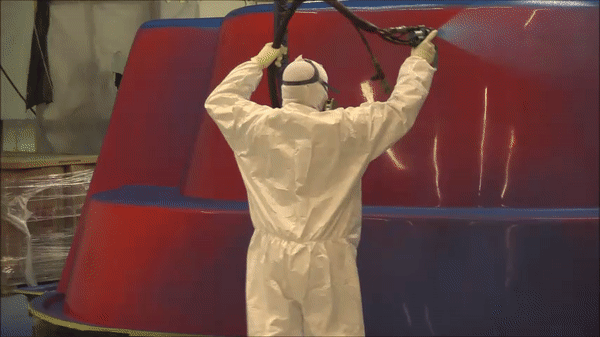Today we’re going to discuss how the gel coat layer of a fiberglass pool is applied in manufacturing, some guidelines used by manufacturers, and the problems that arise when these guidelines are not adhered to.
Ok, we’ve already covered the importance of proper mold maintenance in the fiberglass pool manufacturing process and what occurs when that’s not done correctly. So now we’re ready to actually begin constructing our pool.
Remember, we build pools from the inside out so the first layer applied is the surface layer or gel coat.
This is obviously a critical step in the process because it’s the only layer of the pool that’s visible and comes in contact with the pool owner after construction is complete.
Gel Coat Application FAQ’s
How is The Gel Coat Applied?
The gel coat is sprayed directly onto the mold with a tool similar to a paint gun. The technician will make enough ‘passes’ with the gel coat to achieve the desired thickness.

How Thick Should the Gel Coat Layer of a Fiberglass Pool Be?
Manufacturers typically shoot the gel coat layer of a fiberglass pool somewhere around 28-30 mils thick. Achieving this thickness is vitally important for the following reasons:
- If the gel coat is too thin white spots can appear on the gel coat surface
- If it’s too thick the gel coat layer becomes rigid and spider cracks in the surface can occur during shipping or lifting.
Are There any Other Manufacturing Guidelines?
Yes, when the gel coat is applied to the mold, it is blended with a catalyst that causes the material to “flash”, or harden. This begins the curing process.
It is imperative that the guns used to apply the gel coat are calibrated regularly to insure the correct amount of catalyst is added.
Too much or too little catalyst can result in:
- Lack of durability, a shorter life span
- Cracks in the gelcoat
- The gel coat turning white on the surface
Does the Environment Play a Factor?
Yes, the temperature and relative humidity are also important factors in gel coat application. If the manufacturing environment is out of whack (technical term) it will affect how the gel coat cures, which impacts how long it lasts.
Well, there you go...a quick guide to the gel coat application of a fiberglass swimming pool.
At River Pools, we manufacture top of the line fiberglass pools for customers across North America. If you're interested in getting a fiberglass pool for your home, you can browse our catalog of models, try out our pool pricing calculator, or request custom pricing using the button below.

You can also download our free ebook to learn more about fiberglass pools, or you can visit our extensive video library for more educational video content.

Up Next:
Fiberglass Swimming Pools 101: Manufacturing, Cost, and More
A Guide to Inground Swimming Pool Size, Costs, and Prices: Everything You Should Know
How to Prepare for a Pool: Inground, Above Ground, Indoor, and Rooftop
Jason Hughes
Jason Hughes is a partner at River Pools Virginia, a fiberglass pool installation company based in Warsaw, Virginia. With over 20 years of hands-on experience, Jason has dedicated his career to helping families create beautiful, functional backyards while ensuring every fiberglass pool installation meets the highest standards of quality and safety. In addition to his work with homeowners, Jason serves as a GENESIS instructor with the Pool & Hot Tub Alliance (PHTA), where he teaches fiberglass pool installation best practices to pool professionals across the country. Whether he’s on a job site or leading a training session, Jason is passionate about raising the bar for fiberglass pool installations and helping families make confident, informed decisions as they transform their outdoor spaces.





